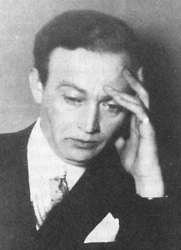MUND Hugó
(1892, Dés - 1961, Buenos Aires)


The posthumous estate of the Mund-Dömötör couple drifted ever farther away from Hungary in the current of history has only become reintegrated into Hungarian art history recently. It is rare that married couples can work without rivalry, mutually enriching each other's work without losing their own individuality. Hugó Mund did not suppress his wife's avant-garde endeavours, and as the press coverage of their many joint exhibitions reveal, they exhibited on an equal footing.
As students of the Budapest Academy of Fine Arts spending their summers in Nagybánya, Gizella Dömötör and Hugó Mund made friends in the artist colony in 1914 Hugó Mund came from the eastern edges of Hungary, from Dés. His career was launched in the years of the First World War under the influence of Ferenczy's colouristic naturalism and Béla Iványi Grünwald's decorative picture construction. Both artists painted several times he typical Nagybánya motifs. While in Dömötörs's works the handing of colour and light strikes the eye, in Mound's Kereszthegy and Híd-Street a greater plasticity can be observed. Despite his military service, Mund stayed in Nagybánya every summer.
The influence of Cézanne and the French modernists can be detected in the work of both painters, especially in variations on the Nudes in the Landscape theme in the 1910s and later. The late 19th century symbolic, Arcadian conception was elaborated further after the example of Hungarian "Seekers" in the work of Dömötör and Mund. In the 1920s the early cubist pieces gave way to a more mystical and expressive approach in Dömötör's oeuvre.
In Hugó Mund's work the classicist tendency when he left Budapest to settle in Transylvania. In 1920-24 they enjoyed the patronage of the bishop of Nagyvárad, working only summers in Nagybánya, where they stayed continuously from 1924 to 1930. They didn't align themselves with a single current. Instead of impressions of nature, they were searching for inner essence in their own peculiar way, not independently of the growing influence of Far Eastern philosophies. That was how cubism and expressionism became fused in their pictures in a belated symbiosis typical of East European art.
Hugó Mund's large summarizing oils - Still-life in the landscape, Nudes outdoor, Landscape with Mountains - matured through innumerable sketches. His work is predominated by the line and tone. His female figures placed in landscapes seem to be religious but are actually profane. These symbolic figures (sometimes Madonnas) convey his conception of eternally reviving human fate. They represent Mund's longing for harmony, his turning away from a world weighed down by ever-greater concerns.
With the gradual worsening of the economic and political situation, the Munds decided to emigrate. They settled in Argentina in 1931. The influence of the avant-garde tendencies had just reached South-America by this time. Mund and Dömötör didn't affiliate with any Argentinean art group, except for Gizella's participation in the exhibitions of the association of British painters. Faithful to her earlier style, she gradually incorporated some local motives into her work. Argentinean peculiarities were quicker to find their way into Mund's pictures, be they the decimated Indian natives, the shepherds of the pampas or the labourers of the suddenly swollen metropolis. In 1935 he took on the librarian's job at the University of law to make a living. He died in 1961.
